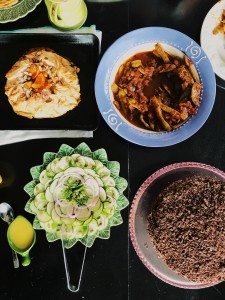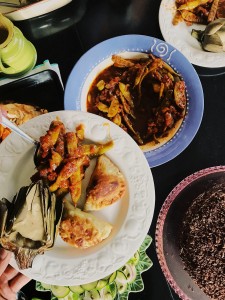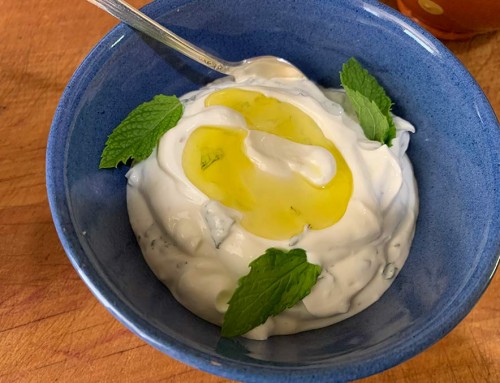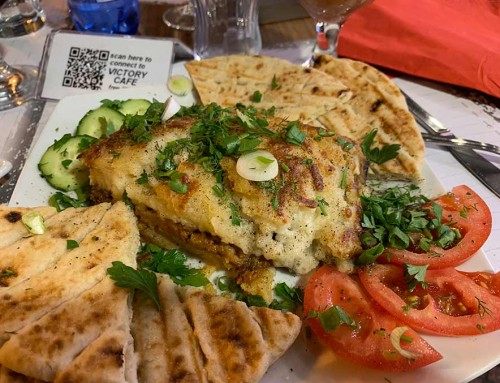Recipes in this article (click links to go directly to a recipe)
Chard Kalitsunia | Stewed Romano Beans | Roasted Artichokes with Garlic Almond Sauce | Sliced Zucchini and Red Onions with Lemon Mint Dressing | Apricot Filo Tart with Coconut Cream
Recently a photographer friend of my niece Roxanne came by the house to take some pictures of me and food for my site and other web content. His name is Don Doblados and he is a wonderful photographer with a love and passion for food. He also happens to be vegan, so to thank him for his time, I offered a vegan Greek dinner.
It’s easy to create a vegan Greek (or Mediterranean) menu since those parts of the world don’t consume a lot of dairy. The Greeks do eat a lot of yogurt and feta, but that’s pretty easy to avoid when building a menu. The bigger challenge was dessert. I made an Apricot Filo Tart but filo is traditionally layered with butter, I needed to find another option. Of course, I LOVE olive oil, and would be happy to eat a dessert made with olive oil, but I understand that others don’t share my love, so I used a combination of almond oil and the very un-Greek coconut oil. Walnut oil would be lovely in this recipe, but is typically double the price of almond oil. I chose the combination of coconut and almond oil because coconut oil is more substantial, kind of more butter-like than almond oil is. Coconut oil makes food extra crispy and helps food to brown quickly when baked or fried.
As is typical of Greek food, much of this menu can be prepped ahead, and the entire thing can be served room temperature so that you’re free to spend time with your guests.
Also pictured is a Swiss Hazelnut Cake which isn’t vegan or Greek! Since it was Claire’s birthday weekend and we were having people over for the dinner it was my excuse to try this recipe. It’s a Cooks Country recipe and has ground toasted hazelnuts in the cake batter, and a Swiss meringue frosting that has marshmallow cream in it! I fundamentally don’t approve of marshmallow cream, it doesn’t meet my real food standards. But I’m a sucker to try a new technique, and I must admit, it makes an excellent frosting. Very smooth, easy to use, good flavor. The recipe adds salt to the frosting which helps offset the sweetness of the marshmallow cream. If interested, click here for the recipe.
Summer is here and the markets are bursting with fruits and vegetables, it’s the perfect time for this menu. I hope you enjoy the recipes, and I know you’ll enjoy Don’s photography.
Chard Kalitsunia
Typically, I make kalitsunia with ricotta or other cheeses, but as a kid it was equally common to find them made with greens and no cheese. Most likely wild greens, onions, and fennel. Since I don’t have a mountain hillside to wander and pick tender seasonal greens I made these with chard, leeks, fennel, and added currents for a touch of sweetness, and to help soak up the extra liquid that the chard gives off. The filling and dough can be made a day ahead. Assemble the kalitsunia shortly before frying them, I know from experience that the longer they sit uncooked the more difficult they can be to fry. However, they don’t need to be served hot, they are great room temperature, so you can cook them earlier in the day. There are no eggs or other ingredients that make these highly perishable so they are perfect to take on a picnic.
Filling:
2 T olive oil
1 leek, quartered and sliced (white part only)
1 fennel bulb, quartered and sliced
Two bunches Swiss chard, washed, stems removed, coarsely chopped
¼ cup water or broth
3 T currents
2 T finely chopped dill
1 t salt
generous pinch red pepper flakes
juice of half a lemon
Dough:
2 C flour
1 t salt
1/3 C olive oil
Enough water to form a dough (about 1/3 cup)
1 ½ C olive oil for frying
First make the dough since it can rest while you’re making the filling. Place the flour and salt in the bowl of a food processor. Pulse several times to combine. Add the olive oil and process until the olive oil is incorporated into the flour. With the machine running add water until the dough just holds together. Remove the dough from the bowl of the food processor, knead several times so that the dough is smooth and holds together. Wrap in plastic wrap and let sit room temperature while you make the filling. Allowing the dough to rest makes the dough easier to use.
To make the filling, place the olive oil in a large skillet over a high heat. Add the leeks and fennel and sauté until the vegetables are lightly browned, about 3-5 minutes. Add the chard and water or broth, currents, salt and pepper flakes and cook until the chard is wilted. Remove from the pan and allow to cool to room temperature. If there is excess liquid in the chard mixture drain it. Add the dill and lemon juice and mix well.
When ready to fry the kalitsunia cut the dough into four pieces. Keep the pieces covered in plastic, remove one piece and roll it on a lightly floured board as thin as you can. Place one rounded spoonful of the filling on the bottom third of the dough and fold the dough over the filling. Using a pastry wheel cut the dough into a half moon shape, crimp the edges with a fork and place on a cookie sheet lined with waxed paper or parchment. Using the same piece of dough, make another kalitsunia. The challenge is to get so good at this you can get at least three kalitsunia off of each strip of rolled dough, but making two is respectable as well! Save the scraps since once all the scraps are collected you’ll be able to get another two or three kalitsunia out of the scraps.
Once all the kalitsunia have been rolled, place the olive oil in a large skillet over a high heat. When the olive oil is hot enough to make tiny bubbles around the handle of a wooden spoon when inserted into the oil, gently ease the kalitsunia into the pan. I typically fry about 4 at a time, you don’t want to crowd them because they won’t fry evenly. Fry until golden on one side (about 2 minutes), flip and fry until golden on the other. Place on a paper towel lined cookie sheet to drain before serving.
Makes about 10 kalitsunia.
Stewed Romano Beans
I love Romano beans, they are flat wide beans that are available summer into autumn. They have a buttery taste and are really the best green bean to stew in tomato sauce. As is the case with anything in tomato sauce, they are best eaten the next day. I love to pile them into Naan bread and top with a generous handful of feta for a satisfying old-world lunch.
Ingredients:
¼ C olive oil
1 onion, chopped
1 garlic clove, sliced thin
1 ½ pounds Romano beans, washed, stems trimmed
1 t dried oregano
1 C red wine
2 C tomato sauce
2 t salt
¼ t ground pepper
Place olive oil in a Dutch oven over a high heat. Add the onion and garlic and sauté until the vegetables are transparent, about 5 minutes.
Add the Romano beans and sauté about 2 minutes more. Add the oregano, wine, tomato sauce, salt, and pepper. Bring to a boil, reduce to a simmer and cook, partially covered for about 30 minutes or until the beans are tender. The beans in this dish will be a grayish green, not a bright green. That’s ok, that’s what happens when a green bean gets a long slow cook. This process will make the beans very tender and delicious.
Place into a serving bowl and serve. I love eating these beans with bread and black olives.
Serves 5-6
Roasted Artichokes with Garlic Almond Sauce
When in a hurry I cut my artichokes in half so that they cook faster. And if I have a lot of things cooking on top of the stove, where I am limited to four burners, the artichokes get roasted in the oven. It’s a very easy way to cook them and baking them slightly browns them, caramelizing them a bit. Of course, you can enjoy them with a drizzle of olive oil and a squeeze of lemon, but I wanted something with a bit more flavor, so I combined salted almonds, garlic and lemon for a dipping sauce.
For the Artichokes:
1 T olive oil
salt and pepper to taste
4 large artichokes, stems trimmed, cut in half lengthwise, choke removed
2 cloves garlic, cut into 8 pieces total
1/3 C water
Heat the oven to 400°. Line a cookie sheet with sides with foil. Spread the foil with the 1 T of olive oil and season the pan (yes the pan) with salt and pepper. Place the artichokes cut side down on the prepared pan, tucking a chunk of garlic under each artichoke half.
Pour the 1/3 C water over the chokes and cover with foil. Place in the oven and bake 30-40 minutes or until the artichokes are tender. Remove from the oven and either serve warm, or room temperature with the dipping sauce on the side.
For the Garlic Almond Sauce:
½ C roasted salted almonds
1 garlic clove
½ C olive oil
zest of one lemon
freshly ground pepper to taste
¼ C water
Place the almonds in the bowl of a food processor and process until the almonds are very finely ground. Add the garlic, olive oil, lemon zest, and ground pepper. Process until smooth. With the machine running, add the water, this will make the sauce even smoother. Spoon into a serving dish and serve.
Sliced Zucchini and Red Onions with Lemon Mint Dressing
This salad looks really fancy but that’s due to the miracle of the mandolin slicer. In fact, it’s very easy to make. Thinly sliced zucchini and red onion are drizzled with olive oil and lemon juice and topped with mint. That’s it!
French mandolin slicers are very expensive. I use the cheap plastic kind that are under $25.00, and it works just great.
Filling:
1 large zucchini, washed, stem end trimmed
½ a small red onion, peeled
juice of one lemon
¼ C olive oil
salt and pepper to taste
1 T mint leaves
1 T pumpkin seeds (or other nut or seed)
Using the mandolin, slice the zucchini thin and arrange on a serving dish. Slice the onion thinly on the mandolin and arrange over the zucchini. Season the vegetables with lemon juice, olive oil, salt and pepper. Arrange mint leaves and pumpkin seeds on top and serve.
Serves 4-6
Apricot Filo Tart with Coconut Cream
Filo is a Godsend, versatile, and easy to use. In the old days, almost no one bought filo so it was often old when we purchased it and the leaves would crumble and be impossible to work with, but not anymore. For best results, allow the filo to thaw overnight in the fridge, and then let sit for about an hour at room temperature before working with it.
I love apricots, eat them as often as I can when in season. This week I found blenheim apricots in the store, so I jumped on them. Blenheim apricots have a very short growing season and are difficult to find since most farmers won’t grow them since they blemish easily and don’t ship well. They are very fleshy, dense and sweet and are excellent for drying.
For Apricot Tart:
8-10 apricots, washed, cut in half, pits removed
1 T cornstarch
¼ C apricot jam
¼ C sugar
1 T orange zest
6 sheets filo
¼ C coconut oil, melted
¼ C almond oil
½ C cinnamon sugar
1 T slivered almonds
Heat oven to 375°. Line a sheet pan with parchment.
Place the apricots in a medium bowl. Add the cornstarch and mix to evenly coat the apricots with the cornstarch. Add the jam, sugar, and orange zest.
Combine the coconut oil and almond oil. Place a sheet of filo on the cookie sheet and brush with the oil mixture, sprinkle with some of the cinnamon sugar. Place a second sheet of filo over the first sheet in, horizontal over the first sheet and brush it with the oil mixture, and sprinkle with some of the cinnamon sugar. Continue to crisscross each filo sheet, brushing with oil, sprinkling with some of the cinnamon sugar until all 6 sheets are on the cookie sheet.
Mound the apricot filling in the middle of the filo and quickly fold the filo over the filling leaving the filling peeking through in the middle.
Brush the tart with any remaining oil and sprinkle with any remaining cinnamon sugar. Sprinkle slivered almonds over the top and bake 25-35 minutes or until golden brown.
Can be served warm, or room temperature. This dessert can’t be made ahead and refrigerated overnight since the filo will get soggy. Serve with coconut cream (or yogurt if you’re not vegan)
For Coconut Cream:
1 can (5.4oz.) coconut cream
1 t vanilla
1 T sugar
Combine the coconut cream, vanilla, and sugar, whisk until blended and serve.








